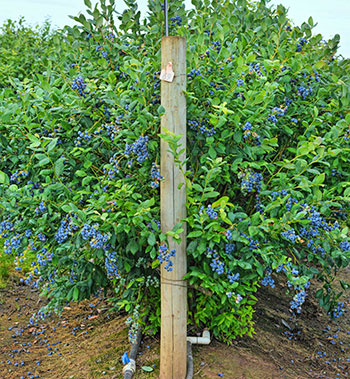Pulse Drip Irrigation Shown as Beneficial in Study
Research by a doctoral student working under USDA Agricultural Research Service horticulturist David Bryla has shown benefits to using pulse drip irrigation in blueberry production, at least when used on Draper planted to sandy soils.
 |
“Overall, we had quite promising results from this study,” said Jesse Carroll in a presentation during the 2022 Oregon Blueberry Field Day, July 20 at the North Willamette Research and Extension Center in Aurora.
The research showed that when applying pulse drip irrigation, a method that involves irrigating daily in 30-minute pulses with a two-hour rest between applications until daily water needs are met, resulted in better yields and no loss of fruit quality.
“Within the first year of application, pulsing increased yield by 1,960 pounds an acre when irrigation was applied at a fixed rate and by 2,940 pounds an acre when irrigation was scheduled based on evapotranspiration,” Carroll said. He added that the pulse drip irrigation treatment used the same amount of water as the standard irrigation treatments.
The research also showed no difference among the standard irrigation treatment and the pulse drip irrigation treatment in fruit firmness, titratable acidity or fruit bud set.
The only apparent drawback of using pulse drip irrigation versus standard irrigation is a slight reduction in total soluble solids in the pulse drip irrigation treatment. The research showed that on average, the total soluble solids with pulsed irrigation were 15.9 percent, versus 16.4 percent when using standard irrigation practices.
Researchers have several ideas of why pulse drip irrigation provided benefits over standard irrigation in the 2021 study, including the soil type of the field where the study was conducted and the high heat of last year.
“The field was quite a light, silt loam soil and the benefit of pulse drip irrigation is that it maintains a higher soil moisture content throughout the day during active plant uptake when compared to standard irrigation that is done every two to four days,” Carroll said.
Jesse Carroll |
“With that light, sandy, silt loam soil, you are prone to irrigation water loss through deep percolation and runoff because there is just too much water there for the plant to use (when using standard irrigation),” Carroll said. “By providing that two-hour rest period with pulse drip irrigation during active hours of plant uptake, the plant is able to utilize more of the water within the soil.
“And also, as we all remember, last year was quite hot and quite dry,” he said. “With that higher soil moisture content found under pulse drip irrigation, we believe we were able to mitigate some of that heat stress that would have led to yield loss under a different irrigation method.”
The bottom line, Carroll said, is pulse drip irrigation appears to deliver significant benefits over standard irrigation practices. “Growers who employ this on silty or sandy soils can expect to produce increased yields and have little to no effect on fruit quality,” he said.
Carroll added that additional research is needed to assess whether pulse drip irrigation performs similarly with different blueberry types and different soil types, especially those soils that are higher in clay content.
“But for right now, it seems like a promising method for northern highbush blueberry,” he said.